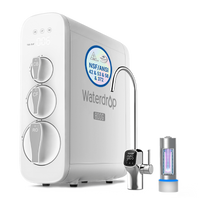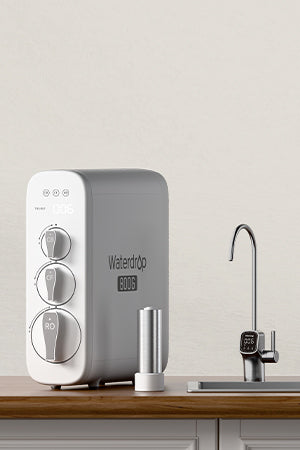The United Nations Children’s Emergency Fund (UNICEF)
suggests that “Access to clean water is a fundamental human right and a
prerequisite for the realization of many other human rights.” When the United Nations (UN) member countries
established a plan for sustainable development in 2015, known as Transforming Our World: The 2030 Agenda for
Sustainable Development, clean water was high on the agenda.
The Transforming Our World: The 2030 Agenda for Sustainable Development plan
consists of several goals known as the Sustainable Development Goals (SDGs). SDG 6.1 of the plan
involves “Achieving universal access to water sources that are improved, with
a round trip for water collection not exceeding 30 minutes, safe from contamination, and available when needed.”
The goals have been set. But how far have we gone in achieving these goals in 2021,
and how much work still needs to be done? These are the questions we want to answer in this article. We start by
looking at how big the safe drinking water challenge is and the initiatives across the globe that are aiming to
ensure everyone has access to clean water on their premises. Finally, we focus on the road ahead.
The Expectations
To determine whether any progress has been made or how much work still needs to be
done to ensure that universal access to safe drinking water becomes a reality, we need to understand what the
standard is. This idea is provided by the UN and the World Health Organization (WHO) through the
Guidelines for
drinking-water quality, 4th edition (GDWQ).
Sufficient: Each person should have a consistent and sufficient supply of
water for personal and domestic use. Sufficient water for each individual is between
50 and
100 liters per day.
Safe: The water for domestic or personal use should not contain chemical
substances, micro-organisms, or radiological hazards that could harm human health. Local or national water
quality measures are often used to determine the safety parameters for safe drinking water.
Acceptable: The odor, color, and taste of water should be of an acceptable
standard as defined by a competent local or national authority, and the water facilities need to be designed in
a manner that considers the lifestyles, culture, and privacy requirements of users.
Accessible: Individuals should not walk over a kilometer or take a round
trip that is more than 30 minutes from their home, school, workplace, or health facility to collect safe
drinking water.
Affordable: The cost of safe drinking water should not exceed
3% of
household income.
The Challenge
As of 2017, the number of people who did not have access to basic water services
(meaning a round trip to an improved water source not exceeding 30 minutes) was
785
million.
About
144 million people were, in 2017, collecting water directly from surface
water sources. This is a reality acknowledged by the UN, which says that “In rural Sub-Saharan Africa millions
of people share their domestic water sources with animals or rely on unprotected wells that are breeding grounds
for pathogens.”
Quick Statistics
The
WHO provides the latest figures we could find showing the global challenges
in access to safe drinking water:
- At least 2 billion people get their water from a source contaminated by feces.
- Using contaminated water is estimated to result in 485,000 diarrhoeal deaths per year.
- Around 50% of the world population is expected to be living in water-stressed areas by 2025. A
water-stressed area is an area that doesn’t have adequate freshwater to meet demand.
- In the poorest countries, 22% of healthcare facilities do not have water services.
The Progress
Even though the figures we present above are grim, the good news is that there are
efforts on several fronts to ensure universal access to safe drinking water. These efforts can be noted at both
country and international levels. The private sector is also playing a considerable role by providing
technologies like
reverse osmosis systems.
A paper produced by the International Institute for Sustainable Development (IISD)
shows the importance of multi-sector collaboration. The institute
says, “The water crisis has never been more urgent, and
partnerships—especially those where we can bring together leaders from business, the public sector, and
non-profits and non-governmental organizations—are a key solution to driving measurable, impactful, and lasting
change.”
The Safe Drinking Water Act
The Safe Drinking Water Act (SDWA) in the United States is an example of a
country-level initiative to make universal access to safe drinking water possible.
According to the United States Environmental Protection Agency (US EPA), the
SDWA “was originally passed by Congress in 1974 to protect public health by regulating the nation’s public
drinking water supply.”
When the SDWA was circulated in 1974, its primary focus was to regulate water
treatment. This was seen as the best means of delivering safe drinking water.
The US EPA
reports that the SDWA was amended in 1996 to enhance “the existing law by
recognizing source water protection, operator training, funding for water system improvements, and public
information as important components of safe drinking water.” The agency adds that “This approach ensures the
quality of drinking water by protecting it from source to tap.”
UN Contribution
From the global front, several intergovernmental organizations, non-governmental
organizations, and private sector companies are involved in initiatives to help deliver safe drinking water.
In September 2011, the UN Human Rights Council
passed a resolution that “calls on
States to ensure enough financing for sustainable delivery of water and sanitation services.” When the UN
brought together member states to establish SDGs, they came up with
Goal 6: “Ensure availability and sustainable management of water and
sanitation for all.”
To shine the spotlight on safe drinking water, the UN has declared 2018 to 2028 the
Water Action Decade.
In an opening address to a meeting on ensuring universal access to safe drinking
water and sanitation, the UN General Assembly President, Volkan Bozkir, provides an idea of why the UN takes the
issue of water and sanitation seriously. He
says, “Access to water is not just about ‘liquid in a bottle’ but instead
touches on universal issues such as dignity, opportunity, and equality.”
The WHO Guidelines
The WHO has also been at the forefront of initiatives to increase access to safe
drinking water. The organization
says, “As the international authority on public health and water quality, WHO
leads global efforts to prevent transmission of waterborne disease, advising governments on the development of
health-based targets and regulations.”
At a practical level, the WHO assists efforts to ensure the availability of safe
drinking water by providing
quality guidelines on such issues as “drinking water, safe use of wastewater,
and safe recreational water environments.” The organization also assists countries that lack the capacity to
implement these guidelines.
NGOs Improving Access To Safe Drinking Water
In a report published in February 2021, the NGO World Vision says, “As of the end of January 2021, we have fulfilled our commitment to
reach 20 million people with sustainable sources of clean water.” This is an example of the role played by the
NGO sector in making safe drinking water more accessible, especially in poor communities.
In the 2021 report, which focuses on the period between October 2019 and September
2020, World Vision provides
statistics to show the impact of its work in deprived communities:
- In East Africa, 5,166 taps were installed to provide safe drinking water.
- In the Middle East, 1,557 taps were installed to ensure that individuals could access water from sources
closer to their homes.
- In Latin America, 7,608 taps were installed to provide communities with a source of safe drinking water.
- In Southern Africa, over half a million people were provided with access to clean drinking water.
The Role Of The Private Sector
Even though many people often look at international organizations, governments, and
NGOs as the main entities responsible for providing safe drinking water, the private sector plays an important
role in developing technologies that help people access clean water.
An excellent example of the involvement of the private sector in increasing access
to drinking water is the proliferation of companies providing
water filtration
technologies on both a large and small scale. These technologies also make it possible to desalinate
seawater (separate water molecules from seawater) and make it suitable for domestic use.
The role played by the private sector in improving water quality is supported by
some scientific studies. For instance, an article published by the Journal of Public Health and Emergency (JHPE)
notes that “membrane
filtration shows a potential to become the preferred water treatment method in the future.”
The JHPE article
adds that “Affordable and effective water treatment is a vital step towards
reducing morbidity, as well as reducing health complications for the present and the future in developing
countries.”
Examples of Contemporary Water Filtration Technologies
Below are some examples of the most innovative technologies in the market to ensure
that all people have access to safe drinking water wherever they are in the world.
Reverse Osmosis Water Filter System: The main advantage of this
system is that it does not include a tank, meaning that no water is stored before being used. This prevents the
buildup of bacteria and viruses. It also saves space.
The Road Ahead
From the statistics above, it’s clear that the issue of universal access to clean
water is a crucial one. It is also clear that a lot has been done to ensure that every human being can get safe
drinking water from a clean source without taking a round trip lasting over 30 minutes from their home, school,
health facility, or workplace.
Notwithstanding the progress, the numbers show that a lot still needs to be done.
For instance, the WHO
predicts that by 2025 more people will be living in water-stressed areas than
is the case today. This shows that access to safe drinking water may remain a challenge for many communities
into the foreseeable future.
The challenges that lie ahead are depicted by the UN, which
says, “In 2020, 129 countries were not
on track to hit the target of implementation of integrated water resources management by 2030, which includes
financing and inter-sectoral coordination mechanisms, basin management, and monitoring.” Concluding, “Globally,
the rate of implementation needs to double.”










































































